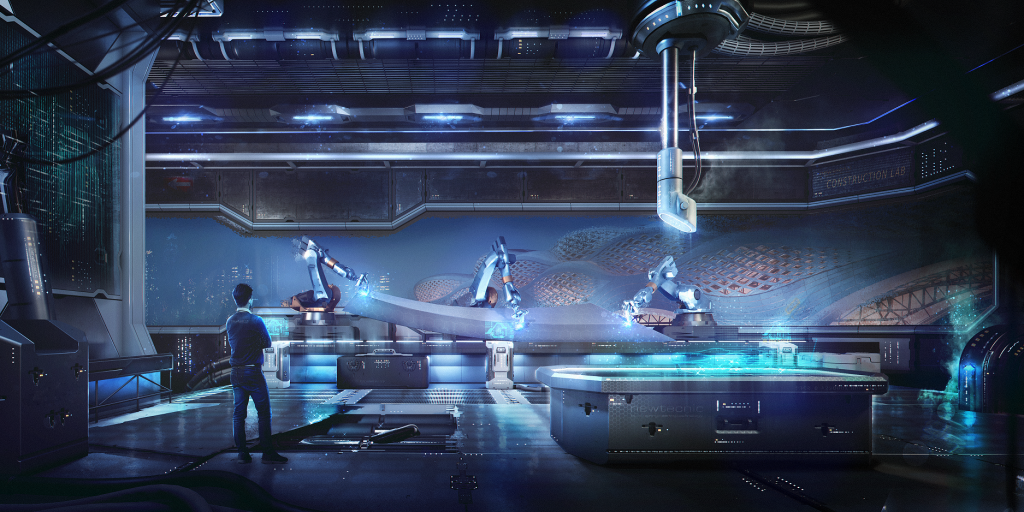Andrew Watts, CEO of international building design engineering company, Newtecnic, looks at how increased efficiency in infrastructure development enables scaleable business responses and brings positive returns for commerce and society.
To flourish, our growing populations need more and better infrastructure – the roads, bridges, security, internet, water, sewage and other public facilities created for government agencies by engineers and construction companies. These, together with cultural infrastructure and public spaces, are vital components of our business and private lives.
The scale and complexity of infrastructure projects mean that to contribute successfully, businesses must adapt and evolve by bringing together and marshalling ever more information. Costly overruns are typical on such projects, but experts agree that many challenges can be overcome through enhanced stakeholder collaboration and verified design engineering solutions.
Culture Club
This is a very exciting time for global infrastructure developments. Europe's largest construction, project, Crossrail, valued at £23bn, will soon see its first trains run through central London. The Panama Canal is being upgraded. Beijing and Dubai are building two of the world’s largest airports. A new bridge will soon connect the US with Canada. India is spending many billions on new smart cities, high-speed rail, ports, airports and energy grids. The pattern is repeating globally as nations invest in their share of the future through projects that drive economic growth.
Cultural infrastructure assets, such as museums, concert halls and theatres also enhance and delight society. Often there are crossovers when for example, a rail hub becomes a city’s social destination with entertainment and retail attractions, or when a public park is sited beside a scenically enhanced water resource.
Spending on national infrastructure pays back around 3 times the investment to society. In the case of broadband, payback can surpass 20 times the original investment and is often the starting point for regional commercial as well as personal transformation.
Late Again
The reality of infrastructure projects is frequently typified by late delivery and escalating costs. 50% overruns are common while demand and benefit forecasts are often wrong by between 20 and 70%. Management misinformation and deliberate deception are further causes of overruns and unplanned costs.
According to New York-based consulting firm McKinsey, global investment in infrastructure needs to increase by 60%, to US$57 trillion worldwide, between now and 2030, just to support projected economic growth. But more spending is not the total answer; McKinsey estimates that improved civil engineering productivity could save US$1 trillion annually worldwide, putting pressure on the civil engineering industry to innovate.
The obstacles of inefficiency are widespread because, in the construction industry, fragmented and often outdated business models are commonly found. Multiple sub-contractors inadequately communicating, results in poor knowledge sharing between themselves and among other stakeholders, professionals and the public. That compounds many other procedural and technical problems which means mistakes are made, waste is generated, and a combative environment exists among those tasked with project delivery.

Depicted in 2038, construction workers and robots work together maintaining the façade of The King Abdullah Financial District (KAFD) Metro Hub in Riyadh, Saudi Arabia.
Project Unity and Funding
On Newtecnic coordinated large-scale projects of national importance with high levels of complexity and risk, contractors and stakeholders use a unified, real-time, expert-knowledge platform that delivers verified design, engineering, installation and operations information. This business methodology allows contributing companies to scale their response, enabling them to capitalize on the unprecedented commercial opportunities that current infrastructure development presents.
Seeing the big picture and all of its details lets them understand their own role in relation to their project partners, and to comprehend how their work interfaces with the project as a whole. This is crucial because it is at junctions (either physical or contractual), that many problems can arise. Without rigorous engineering discipline applied at the earliest stages of - and throughout projects, errors, unforeseen risks and therefore costs and delays intensify during the construction phase.
Unifying subcontractors on a common platform is common in manufacturing but rarely used in civil engineering. However, when such platforms are deployed, collaborative business models, based on 3D digital twins of projects, help reduce risk, waste and rework by integrating and unifying on- and off-site project teams, manufacturers and fabricators.
Digital Twins
Newtecnic develops digital twins based on engineering designs developed from first principles. These ultra-realistic 3D models are presented on dashboards that incorporate every aspect of construction including components and processes. Designs are digitally verified before any physical work commences so that potential issues come to light and can be ‘engineered out’ in advance.
Examples of this way of working can be seen on Newtecnic design engineered infrastructure projects. These include the King Abdullah Financial District Metro and its extended urban network in Riyadh, Saudi Arabia, The Grand Theatre de Rabat in Morocco and the Changsha International Culture and Arts Centre, comprising 4 very large, complex buildings and their surrounding infrastructure, in China. These projects are delivered with the benefit of verified engineering coupled with unified cloud-based communications to all stakeholders via advanced but easy to comprehend project dashboards.
Equipped with 3D printing and additive manufacturing capabilities, Construction Labs are small but efficient manufacturing cells located at worksites. In these temporary factories skilled craftspeople using locally sourced materials, deploy very advanced machinery to produce mass customised components. This saves time, improves logistics and means that manufacturing can be fine-tuned to current project circumstances.
As robots become more advanced, they will interact with Construction Labs generating, moving and installing both new and replacement building parts. Using Construction Labs means that production can be scaled to precisely match project progress.

It’s the year 2038, and inside the Newtecnic Construction Lab, additive manufacture is used to make replacement façade panels for the King Abdullah Financial District (KAFD) Metro Hub in Riyadh, Saudi Arabia.
Advancing Society
Multi-discipline collaboration platforms also help infrastructure projects attract investment capital. Investors demand openness and transparency because they know they can reduce financial, reputational and political risk by ensuring project information is available to all parties in the formats that serve them best.
Investors also want to see rapid completion so they can beat competitors to revenue streams. Being armed with this type of information provides an important competitive advantage together with the surety of more successful project outcomes. Many investors therefore encourage verified knowledge sharing to achieve collaboration with governments, contractors and the public.
Using a unified, scaleable cloud-based information system to align objectives among diverse groups ensures that any number of parties are connected to and can simultaneously collaborate to innovate around current designs and associated information in meaningful ways.
The next logical step for major infrastructure projects is to deploy technology that reduces fragmentation, unifies documentation, and thereby harmonizes and accelerates design and construction, flexibly, at any scale. That is being achieved by introducing collaborative working practices based on assured components and optimised construction methods. Turning verified data into accessible knowledge by this means delivers better operational efficiency and improved financial returns for infrastructure investors, stakeholders and users.
Increased demand for on-time, on-budget projects, coupled with a new focus on profits, is pressuring civil engineering companies to embrace efficiency and become more productive. The rewards for this industry transformation through engagement with new ideas leads to substantial financial and social benefits without costing an extra penny.
10 Tips for Infrastructure Innovation at any scale
- Use engineering to discover and eradicate component and construction method problems
- Assure on-time and on-budget delivery by optimising processes regardless of scale
- Reduce supply chain fragmentation using a shared data platform
- Real-time knowledge sharing cuts waste and errors
- Verify designs digitally before physical work commences
- Look at manufacturing to understand vertical integration
- Deploy 3D digital twins to better understand the project
- Use On-site Construction Labs to flexibly produce mass-customised components
- Introduce transparency for investors using collaborative technology
- Align diverse groups on the cloud

Seen in 2038, at Changsha International Culture and Arts Centre 3D printers are deployed in a Construction Lab to manufacture replacement building components.










